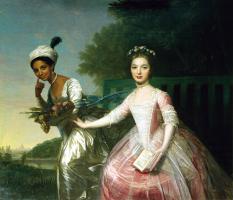 Around 1779, a portrait of two young women was commissioned by William Murray, 1st Earl of Mansfield. The women were Elizabeth Murray and her cousin Dido Elizabeth Belle. For its day, the painting was controversial, even shocking.
Around 1779, a portrait of two young women was commissioned by William Murray, 1st Earl of Mansfield. The women were Elizabeth Murray and her cousin Dido Elizabeth Belle. For its day, the painting was controversial, even shocking.
Dido Elizabeth Belle was a dark-skinned mixed-race woman while her cousin was a fair skinned English woman, and yet in the painting, they were represented as having equal status. Both are dressed in fine gowns. Typically in a painting of the period, servants or others of a lesser class would be painting lower in the composition. Belle and Murray are painted as equals, as indeed they were, at least in William Murray’s household.
In addition to being 1st Earl of Mansfield, William Murray was also the Lord Chief Justice of England and Wales. It is very possible that Belle’s presence in the Earl’s household significantly influenced his verdicts on key cases which led directly to the eventual abolition of slavery in the United Kingdom.
Dido Elizabeth Belle, born in the British West Indies around 1761, was the daughter of Royal Navy Captain John Lindsay and a slave, Maria Belle. Captain Lindsey was later knighted and retired as an admiral. As the daughter of a slave, Belle was also considered a slave. When Captain Lindsay returned to England in 1765, he brought his young daughter and left her in the care of his uncle William Murray. The Murrays had no children of their own and the Earl and his wife raised Belle as a member of their household.
In 1766, Murray also took into his care another great-niece, Elizabeth Mary Murray, who was one year older than Belle. The girls were second cousins but were raised almost as sisters. Belle was educated as a free gentlewoman at Murry’s Kenwood House just outside of London. Belle would live there for 30 years.
William Murray had a long and distinguished legal career but is best remembered for Somersett’s case, in which he ruled that slavery had no basis in English common or statue law, which brought an end to slavery in Britain itself, though did not end the slave trade or colonial slavery. He also ruled in the notorious Zong massacre in which the ship owners of the slave ship Zong filed insurance claims for over 100 Africans who had been thrown overboard to drown after the ship began to run short of potable water. Chief Justice Murray narrowly ruled against the ship’s owners.
In his will in of 1793, the Earl confirmed Belle’s freedom and provided an outright sum and an annuity to her, making her an heiress.
The painting of Belle and Elizabeth is owned by the current Earl of Mansfield and housed at Scone Palace in Perth, Scotland.

I’ve had a look at the Zong case, Gregson v. Gilbert, 99 English Reporter 629, and come to the conclusion that it is a case of particular, not general, average, in which insureds sued their underwriters for refusal to pay a claim. There was no joint venture of cargo and carrier to implicate the law of general average. Gregson (and his partners) owned both the Zong and her human cargo. Moreover, the jury verdict for the Zong’s owners was overturned on motion by the underwriters, and a new trial ordered. See, e.g., Marouf Hasian Jr., Domesticated Abolitionism, the ”Human Cargo” of the Zong, and the British Legal Usage of Dehumanizing Rhetoric, 1783-1807, 76 Western J. of Communication 503 (2012); James Oldham, (2007) Insurance Litigation Involving the Zong and Other British Slave Ships, 1780-1807, 28 J. of Legal History 299 (2007). There seems to be no evidence that a second trial ever took place. As far as can be ascertained then, the underwriters never paid.